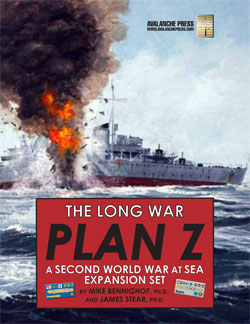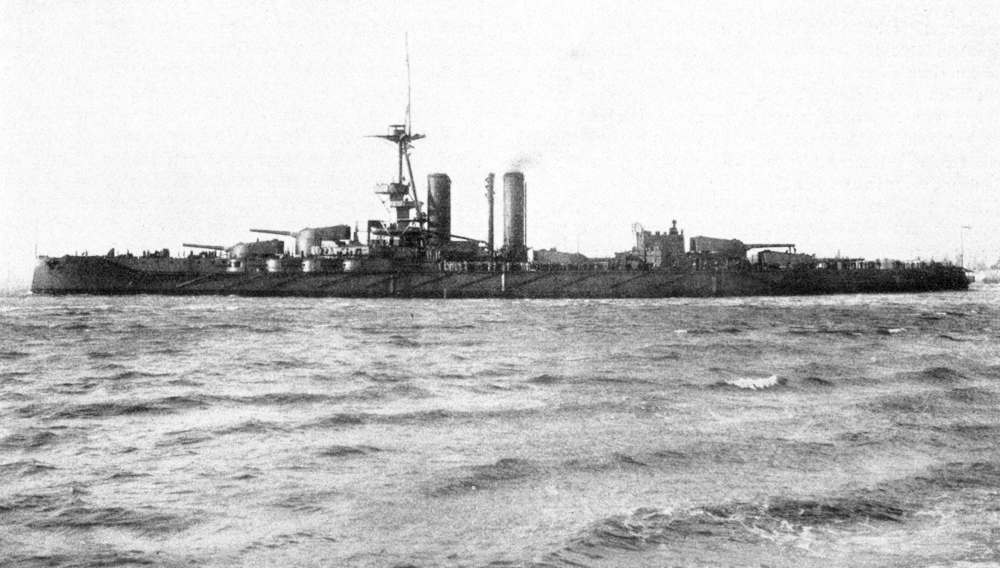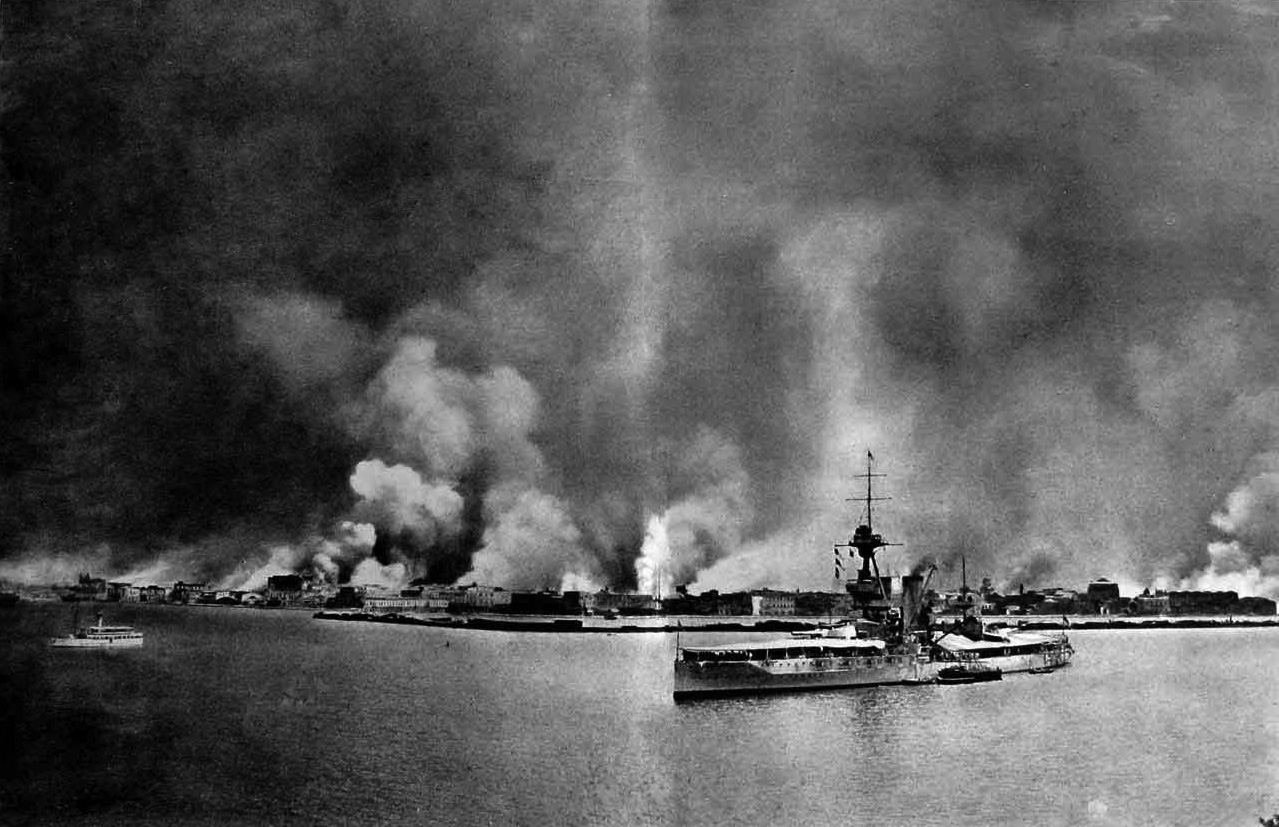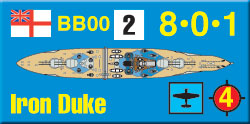Plan Z:
Iron Duke
by Mike Bennighof, Ph.D.
June 2021
 Proud Grand Fleet flagship at Jutland in 1916, by September 1939 the battleship Iron Duke had been reduced to a gunnery training ship, sent to Scapa Flow to serve as a somewhat mobile anti-aircraft battery. With her armament and boilers reduced, she had little military value Proud Grand Fleet flagship at Jutland in 1916, by September 1939 the battleship Iron Duke had been reduced to a gunnery training ship, sent to Scapa Flow to serve as a somewhat mobile anti-aircraft battery. With her armament and boilers reduced, she had little military value
That had not stopped Prime Minister Stanley Baldwin and his government from considering her re-activation as a full-fledged battleship when they came to power in December 1935. Iron Duke
had only been out of service for about four years when the Baldwin government began its program to rebuild all useful warships for service in the war that seemed likely if not inevitable in the near future.
Iron Duke had continued to see action after the end of the Great War, serving in the Black Sea alongside her three sister ships to support the White faction in the Russian Civil War. She remained in the Mediterranean afterwards, helping to rescue survivors of the Great Fire of Smyrna in 1922. She moved to the Atlantic Fleet in 1926, remaining there until decommissioned in 1931.

Iron Duke as completed, 1913.
The London Naval Treaty of 1930 required the scrapping of three of the Iron Duke class battleships, along with the battle cruiser Tiger, to make way for the new replacements (the second King George V class) allowed beginning in 1937 (15 years after the signing of the Washington Naval Treaty). The fourth battleship could be retained as a training ship, under severe restrictions: all but three of her main gunnery turrets had to be removed, her belt armor and any torpedo tubes had to be removed, and her power plant had to be reduced so that she could make no more than 18 knots.
After some gunnery trials in which Iron Duke fired at her sister ship Emperor of India, she underwent conversion to a training ship as the treaty required. Her armor and turrets were placed in storage along with the turrets from the scrapped battle cruiser Tiger (but apparently not those from the three other ships of the Iron Duke class). Anti-aircraft guns and directors were fitted on the barbette.
Iron Duke spent most of the 1930’s based in Portsmouth, training new gunners on short cruises through the Solent and around the Isle of Wight. When war came she moved to Scapa Flow, and there lent her fairly weak anti-aircraft armament to the base’s defenses while serving as a decoy battleship. German pilots took the bait on 16 October 1940; none of the bombs from a flight of Ju88 aircraft actually hit the old battleship, but numerous near-misses opened seams in her hull and flooded a boiler room and two magazines.

Iron Duke is present as Smyrna burns, 1922.
Her crew managed to beach the ship, and after some minor repairs she moved to a new anchorage but continued to leak. In January 1940 she was intentionally grounded again and her “black gang” left the crew. She remained in place for the rest of the war, serving as a depot ship and anti-aircraft station, suffering minor damage in another air attack in March 1940. Finally in August 1946 Iron Duke was patched up enough to be towed and went to the Clyde for scrapping, not meeting the torches until November 1947.
Iron Duke’s sad fate might
well have been avoided. Worldwide, three battleships became training vessels under the London Treaty’s terms: the American Wyoming, the Japanese Hiei and Iron Duke. The Americans considered returning Wyoming to battleship status following the losses at Pearl Harbor, she proved more valuable training gunners for the huge number of new ships entering commission than as an obsolete battleship.
The Japanese went all-in on rebuilding Hiei, restoring her armament and armor (with improvements to both) and giving her a new oil-fired power plant. They lengthened the ship, added modern fire control and improved her internal subdivision. As modernized, Hiei became a modern fast battleship and carrier escort, and would be lost in Ironbottom Sound off Guadalcanal.

Iron Duke as a gunnery training ship.
Iron Duke could have undergone a similar transformation. The Director of Naval Construction considered such a project but British resources could not be stretched to include Iron Duke as well as the new ships under construction and older and more useful ones receiving modernization. In our Second Great War and Long War alternative histories that’s less problematic: the Second Great War posits an early end to the First World War and a mild Great Depression, while the Long War (the setting for Second World War at Sea: Plan Z) places British entry into the Second World War three years later than the actual event.
The reconstruction of the Queen Elizabeth class which followed Iron Duke provides a model for how this would have likely proceeded. Three of the five Queen Elizabeths were rebuilt in the late 1930’s, with little of the original ship retained beyond the main guns and the outer hull. New, more powerful but smaller engines were fitted, armor protection was totally redesigned including a thicker armored deck, and internal subdivision greatly increased.

Iron Duke aground in Scapa Flow.
Iron Duke could have received the same treatment; while she was slightly smaller than Queen Elizabeth the engines fitted in Warspite (the first ship rebuilt) saved enough space to leave the forward boiler room vacant in that ship. The same power plant would have easily fit Iron Duke, more than doubling her original power output. That would not have changed her hull form, so the old battleship probably could not have made much more than 22 knots.
Externally, Iron Duke would have received the same heavy bridge structure of the rebuilt battleships and new ones like King George V, plus a fairly heavy anti-aircraft suite and an athwartships catapult for seaplanes.
Armament would pose a greater challenge. Queen Elizabeth carried the 15-inch Mark I naval rifle, a superb weapon that also armed the Royal Sovereign class battleships and the three battle cruisers still in service plus a pair of monitors. The Royal Navy had 184 barrels for this weapon, steadily rotating them between active warships and refurbishment. Though an old gun, it remained effective.
 Britain did retain a smaller but similar stockpile of the 13.5-inch Mark V that armed Iron Duke, using them in a coast-defense role. But even in 1931, Iron Duke’s main guns were noted as “worn out” and the 57 barrels still in stock likely were no longer suitable for use in a battleship. However, the new 14-inch Mark VII that armed King George V would fit in the cradles of Iron Duke’s turrets (a design feature to allow testing aboard Iron Duke, though this was not actually carried out). Refurbishing the turrets and fitting the new guns would have been very expensive, as the Royal Navy discovered when constructing the fast battleship Vanguard using old turrets from former battle cruisers. Britain did retain a smaller but similar stockpile of the 13.5-inch Mark V that armed Iron Duke, using them in a coast-defense role. But even in 1931, Iron Duke’s main guns were noted as “worn out” and the 57 barrels still in stock likely were no longer suitable for use in a battleship. However, the new 14-inch Mark VII that armed King George V would fit in the cradles of Iron Duke’s turrets (a design feature to allow testing aboard Iron Duke, though this was not actually carried out). Refurbishing the turrets and fitting the new guns would have been very expensive, as the Royal Navy discovered when constructing the fast battleship Vanguard using old turrets from former battle cruisers.
The ship that emerged from the dockyard would have been a costly project, but one suitable for most second-line battleship duties. She would be too slow for use in carrier task forces, but a capable convoy escort.
A sentimental favorite bearing the best battleship name ever, the rebuilt Iron Duke appears in our Second World War at Sea: Horn of Africa as well as Second World War at Sea: Plan Z.
Click here to order Second World War at Sea: Plan Z (book edition) right now.
Please allow an extra two weeks for delivery.
Sign up for our newsletter right here. Your info will never be sold or transferred; we'll just use it to update you on new games and new offers.
Mike Bennighof is president of Avalanche Press and holds a doctorate in history from Emory University. A Fulbright Scholar and NASA Journalist in Space finalist, he has a whole passel of books, games and articles on historical subjects.
He lives in Birmingham, Alabama with his wife, three children and his dog, Leopold. Leopold is well-designed.
|
